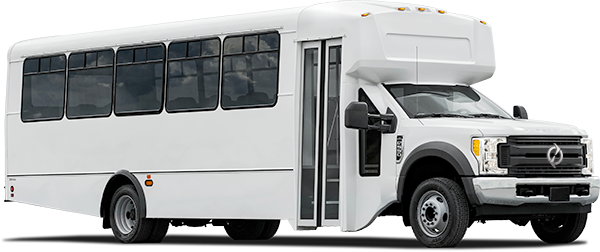F-550 BUS

Lightning Electric Zero Emission F-550 Bus
The Lightning Electric F-550’s electric powertrain delivers great range and efficiency while providing a quiet, smooth and familiar driving experience that your drivers will love. With a range of over 100 miles, this vehicle provides practical, reliable service while producing zero emissions on the road. Charging is flexible, with Level 2 AC charging as standard, and DC Fast Charging availble, providing up to 80 kW for a fast turnaround.
We use the highest-quality components available, including our thermally-managed batteries which deliver the best range, efficiency and lifetime of any batteries in the market. The batteries are fully under the floor so your cargo or passenger space isn’t compromised.
✓ Battery-electric vehicle
✓ Smooth, quick and quiet
✓ Elegant integration with batteries fully under the floor
✓ CARB certified
✓ Installation, maintenance and service performed by Lightning eMotors or certified partners
✓ Lightning Analytics gives insight into usage and efficiency
✓ Available New or Repower
Specifications
| Base Chassis | Ford F-550 (regular cab) |
| GVWR | 17,500 - 19,500 lbs |
| Minimum Wheelbase | 217 in |
| Electric Vehicle Supply Equipment (EVSE) Compatibility | Level 2 (6.6 kW, 13.2 kW optional) DC Fast Charge (up to 80 kW) Connector J1772 CCS-1 Combo |
| All Electric Range* | 100 miles |
| Battery Capacity | 128 kWh |
| Charge Time | 15.5 hours (Level 2 at 6.6 kW) 8 hours (Level 2 at 13.2 kW) 2 hours (DC Fast Charge at up to 80 kW) |
| Maximum Speed | 65 mph (electronically limited) |
| Peak Power | 241 HP (180 kW) |
| Torque Rating (after transmission) | 811 lb-ft (1100 Nm) |
| Warranty | • Base Chassis: Ford standard warranty • EV Powertrain: Lightning eMotors standard warranty (Powertrain and battery 5 year / 60,000 miles) |
| Analytics | • Preventive Maintenance • Range Analysis • Driver Behavior |
* All-electric range can vary depending on route or drivecycle, environmental conditions, vehicle or equipment configurations, and driver behavior.
** Payload and Passenger capacity can vary and greatly depend on vehicle wheelbase, seating configuration, and other characteristics or features as delivered by the OEM or chassis manufacturer. Equipment added to the base chassis by aftermarket upfitters or equipment installers could also affect Payload and Passenger Capacity.